The latest Mini is a bit bigger now – and slightly smaller engined.
Usually, that’s a recipe for slower – and drinks more gas.
Would you believe (best Maxwell Smart voice) this one also goes faster – and uses less gas?
Now, the Mini is not perfect. Which I will get into below. But it’s become a much more practical car than it used to be, while still being as exuberantly adorable as a litter of British bulldog puppies.
WHAT IT IS
The Mini is a two-door/four seater (five in a pinch) subcompact cutester – a reincarnation (via BMW) of the iconic ’60s British micro-car.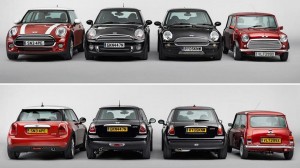
Initially there was just the one model (way back in 2002) but there are now multiple Minis: The two-door/two-row hardtop and convertible, the high-performance Mini S (and even higher-performance John Cooper Works Mini), the two-seater/chopped-roof hatchback Mini coupe, the Countryman wagon and the Paceman – a large (for a Mini) two-door crossover SUV.
This review will cover the Mini hardtop, which starts at $20,700 with six-speed manual transmission.
Opting for the six-speed automatic bumps the base price to $21,950.
Possible cross-shops include the Fiat 500, which is a smaller, tighter fitting (and less expensive) car but comparably cute, the Kia Soul and maybe even the Nissan Cube – which looks kind of like a squatting Samurai but like the other slot cars in this segment has a very playful personality.
The Mini was subtly – but significantly – redesigned last year. Though at a glance it appears unchanged, the current Mini is 5.3 inches longer overall than the previous generation Mini and has a noticeably more spacious interior, especially the backseats (leg and shoulder room) and cargo area, which is about 20 percent larger.
The wheelbase is longer, too – and that along with adjustments to the suspension have markedly improved the car’s ride quality.
Tech features include pedestrian/object detection, an optional Heads Up Display (HUD) and a semi-self-driving automated parallel parking system – though it’s hardly needed in a car this agile and still abbreviated in dimensions.
But the huge news is the smaller engine – a turbocharged three that produces more power than the previous four, gives the car better performance (especially with the optional automatic transmission) and does it without drinking more fuel.
It’ll put a smile on your face.
It won’t put the arm on your wallet.
You won’t need to buy (or rent) a second car to go shopping – or pick up family at the airport.
WHAT’S NOT SO GOOD
Gas mileage can be very good, but gas tank is smaller than it used to be.
If you “motor hard” the Mini will run low sooner than you might expect.
Turbo three requires premium fuel.
While the Mini itself has gotten larger, its engine is now smaller: A 1.5 liter three-cylinder instead of the former 1.6 liter four.
But – via the expedient of “twin power” turbocharging – the new three makes more horsepower than the old four. The hp number is up to 134 vs. 121 previously. And the turbo three produces a bunch more torque: 162 ft.-lbs. of of torque vs. the four’s 114 ft.-lbs.
This is a big difference, especially torque-wise (which is the twisting force that gets a car moving). And the net result is a snappier-performing Mini – particularly automatic-equipped models. Which (would you believe?) are now actually slightly quicker than the manual-equipped versions.
Zero to 60 takes 7.3 seconds with the six-speed automatic – and about 7.4 with the six-speed manual.
Previously, the manual Mini was the quicker ride – and the automatic the slow ride. It took 9.5 seconds to get to 60 (the manual car did it in just over 8).
Why the disparity?
Check those torque numbers again. The turbo three produces 48 ft.-lbs. more torque – and it’s produced at just 1,250 RPM. The retired four not only made a lot less torque, it didn’t make it until 4,250 RPM. That meant it was necessary to really work the engine to get the car going. But at least with the stickshift, you could rev the engine up to where the torque (and hp) were being made, then slip/sidestep the clutch to make the most of the available power. But bolt that torque-and-hp-deficient four to an automatic transmission and you can’t do that.
Turbocharging end-runs this problem by boosting the little three’s output at low RPMs, so there’s plenty of power right now – with the shifter in Drive – and without having to wait for the engine to rev up much.
And there is the additional benefit of on-demand power.
If you’re foot is light on the pedal, the engine’s smaller displacement (and reduced pumping losses due to the nonexistence of a fourth piston going up and down all the time) means it burns less fuel: 29 city/41 highway vs. 29 city, 37 highway for the previous Mini with the 1.6 liter four.
But – when you need it or just want it – more power is readily available. Pushing down on the accelerator causes the turbocharger to compress the incoming air. The more air (and fuel) you can stuff into the cylinders, the more powerful the ensuing explosion – and the faster the car will go.
But the turbo only does its thing when called on by your right foot. Back off the accelerator and the boost wicks down; when just puttering along, you enjoy the fuel economy advantages of a smaller engine.
The one hair in the soup is that the turbo three is designed to burn – and so requires – premium fuel.
“Requires” doesn’t mean you have to feed it premium. You can fill up with regular, but the result will probably be reduced power (and mileage) because while the Mini’s engine can adjust itself to burn lower-octane fuel it’s not optimized to burn lower-octane fuel. Put in plain language, you won’t hurt your Mini by feeding it regular, but you won’t get the best mileage (or performance) out of it.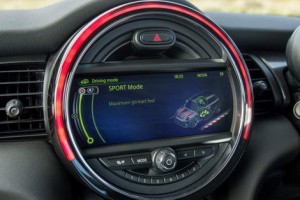
To get it, you’ll have to spend the extra 20-30 cents per gallon for premium – which puts a bit of a dent in the Mini’s otherwise admirable fuel economy stats.
Most economy-minded cars (which the Mini ostensibly is) are designed to do their best on regular unleaded, for obvious reasons. It’s not unexpected that the Mini S – the high-performance version of the Mini – wants premium.
But it is surprising that the regular Mini wants it, too.
The Mini’s turbo three doesn’t feel – or sound – turbocharged. No whistle, no “kick in the pants” when the boost comes online. Whereas in the past, turbos were bolted on to do exactly that, here the mission is to mask the engine downsizing from a four to a three. To maintain not just the power/performance of a larger (and not-turbocharged) engine but to mimic its steady power delivery.
Which the turbo three does, brilliantly. If you didn’t read the specifications (and if the engine didn’t require premium) you’d never guess that you were driving a turbocharged car, much less a three cylinder-powered car.
Previously, the manual-equipped Mini was the only way to go. Because the automatic-equipped Mini was almost pathetically slow. Now, you can go either way without sacrificing performance or economy.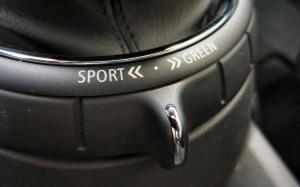
All Mini’s have three driver-selectable programs which can be engaged by a typically Mini spiffy rotating plastic ring at the base of the shifter stalk. Thumb it to the right for Green/economy (“let’s minimize!”) or to the left for mid-range Sport (“let’s motor!”).
Most snarky of all – “let’s motor hard!” (that’s one more nudge to the left).
As is typical of such programs, the sportier the mode you select, the faster (and firmer) the shifts, the more responsive/aggressively the drivetrain reacts. In economy mode, though, there is an additional – and not-typical behavior: A “coast” mode that reduces engine RPM to idle until pressure on the accelerator is resumed. It’s like putting the transmission in neutral at 60 or 70, except it happens automatically and without the dangers associated with coasting, such as a “runaway” car or having to remember to put the transmission back into gear. Also, it’s designed to do this without hurting anything. Manually putting an automatic in Neutral at 60 or 70 MPH – and then back into Drive – might damage the transmission.
As you engage each mode, the Mini’s LED cabin mood lighting (standard in all trims) changes color – green for economy, orange red for normal and cherry red for sport.
This slightly bigger, slightly longer-wheelbased and slightly heavier-than-before Mini feels more substantial, less darty. Wind gusts affect it noticeably less than earlier (and smaller and lighter) Minis. The ride is still on the firm side, but this can be modulated softer – or firmer – by selecting from the three available wheel/tire combos. The base trim comes with 15s, which deliver the softest ride. Or, go with the optional low profile (short/stiff sidewall)18s, which provide sharper steering response and more grip in the corners, but also butch up the ride quality.
An adjustable/multi-mode suspension is also available. 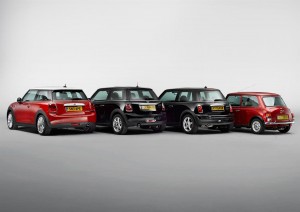
Though it’s some five inches longer overall, the Mini is still mini (including its turning circle, which is just 35.5 feet, only slightly more than before) and can be Froggered through traffic with ease. The upticked power enhances the little car’s natural advantages, including its excellent forward (and to either side) visibility, which can be credited to the upright and fairly tall glass that’s all around you.
The Mini is a blast to drive, especially in urban/suburban traffic. It’s also exceptionally easy to park. So easy, in fact, that the optional automated parking system is pretty superfluous.
One nit, though: Mini has downsized the fuel capacity to 11.6 gallons from 13.2 previously. This makes the Mini seem thirstier than it actually is.
Penn and Teller must have been hired by Mini (BMW) to consult on the design of this car.
I’ll explain.
It just happened that the week I had the Mini, we had guests. My sister, her significant other and my nine-year-old niece. All of which – plus me, plus the baggage that accompanied them on their long-haul flight from San Diego to The Woods (rural SW Virginia) – had to fit inside the Mini for the trip home from the airport. A 40 minute drive.
No cheating by roping stuff (such as my nine-year-old niece) to the Mini’s roof.
Well, the Mini took all four of us, plus three backpacks and a 32x21x12 suitcase on wheels thing that could have carried my niece inside.
It actually fit in the Mini. Behind the second row – which was not folded flat. Or even forward. This was an Our Lady of Lourdes miracle, as far as I am concerned. And neither my sister nor my niece had to assume the fetal position in order to sit in the second row with 6 foot 3 me in the driver’ s seat and nearly six-foot niece’s dad sitting next to me in the front passenger seat.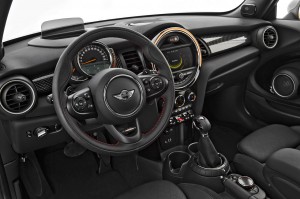
It was tight – but not torturous.
Front legroom in the Mini has always been good – especially for such a tiny-on-the-outside car. It still is (41.4 inches, comparable to what you’d find in many mid-sized cars). But now there’s viable backseat legroom – 30.8 inches (several inches more than in the new Mercedes CLA sedan) about three inches more shoulder room and about 20 percent more cargo room: 8.7 cubic feet vs. 5.7 previously. Fold the second row and you’ve got 38 cubes – effectively, more “trunk” space than you’d have in many full-size cars.
Also, being German-designed, the Mini has superior headroom – which Japanese-designed cars sometimes lack. There’s 40.3 inches up front – so even with the optional sunroof, a very tall man (me) still has several inches of air gap between the crown of his head and the headliner.
Another “German” thing is seat heaters that get hot. As opposed to merely getting vaguely warm.
Thoughtful – and useful – design touches include a pair of adjustable side-window sun glare blockers (in addition to the usual two you get for the windshield) and retro-themed but gratifyingly tactile toggle switches for the various functions. The car also makes “happy” sounds, including the pleasantly muted and old-timey tick-tock turn signal indicator and the pinball machine-like cheerful bumpa-bumpa-bumpa themes for the park sensors and so on.
THE REST
The Mini is mass produced but can be custom-configured to such an extent that your Mini may be the only one exactly like it. Two-tone Jelly Belly paint treatments, various stripe/decal packages – plus a bevy of a la carte (and packaged) optional equipment. You can “minimalize” – and keep the price around the entry-level $20k price point. Or you can load the car up with luxury and technology equipment (including a heads-up display, 10 speaker premium audio rig and a fan-cooled dock for your cell phone).
My test car was the latter – loaded – and the MSRP came to $33,095.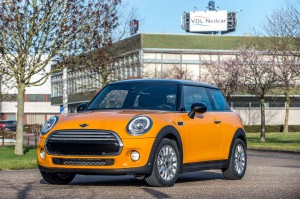
All Minis come with a “boot to bonnet” free scheduled maintenance deal for the first three years or 36,000 miles. Some car companies’ free maintenance deals are borderline fraudulent in that most new cars don’t need much maintenance (beyond really basic stuff, such as oil and filter changes) for the first three years or 36,000 miles and the stuff these plans “cover” is either stuff that probably won’t need to be done or which (like an oil change) wouldn’t cost you much anyhow.
But Mini’s deal includes stuff that probably will need to be dealt with before three years or 36,000 miles elapse – including wiper blade replacement and brake pads and brake fluid.
One final thing: I experienced a “bug” while driving the Mini. That is, a software problem that came – and went. After going to a Starbucks for coffee, the car’s gear selector would not budge out of Park. Not until I accessed and depressed the emergency release under the shifter cover, anyhow. And then the transmission acted oddly (would not upshift).
It may have been a glitch with this particular car – or something more general. I don’t know which. I was able to “fix” the problem by disconnecting and reconnecting the battery, which rebooted the computer. But it’s a little unsettling to need to do that in a brand-new car. The most unsettling aspect being that the problem just sort of cured itself and (as far as I could tell) there was no evidence of the problem ever having occurred. (See here for the full story).
THE BOTTOM LINE
It’s still as cute as ever – but more plausibly practical, too.
Here’s to hoping the “bugs” have been found – and fixed.
If you value independent media, please support independent media. We depend on you to keep the wheels turning!
Our donate button is here.
If you prefer to avoid PayPal, our mailing address is:
EPautos
721 Hummingbird Lane SE
Copper Hill, VA 24079
PS: EPautos stickers are free to those who sign up for a $5 monthly recurring donation to support EPautos, or for a one-time donation of $10 or more. (Please be sure to tell us you want a sticker – and also, provide an address for us to mail the thing to!)


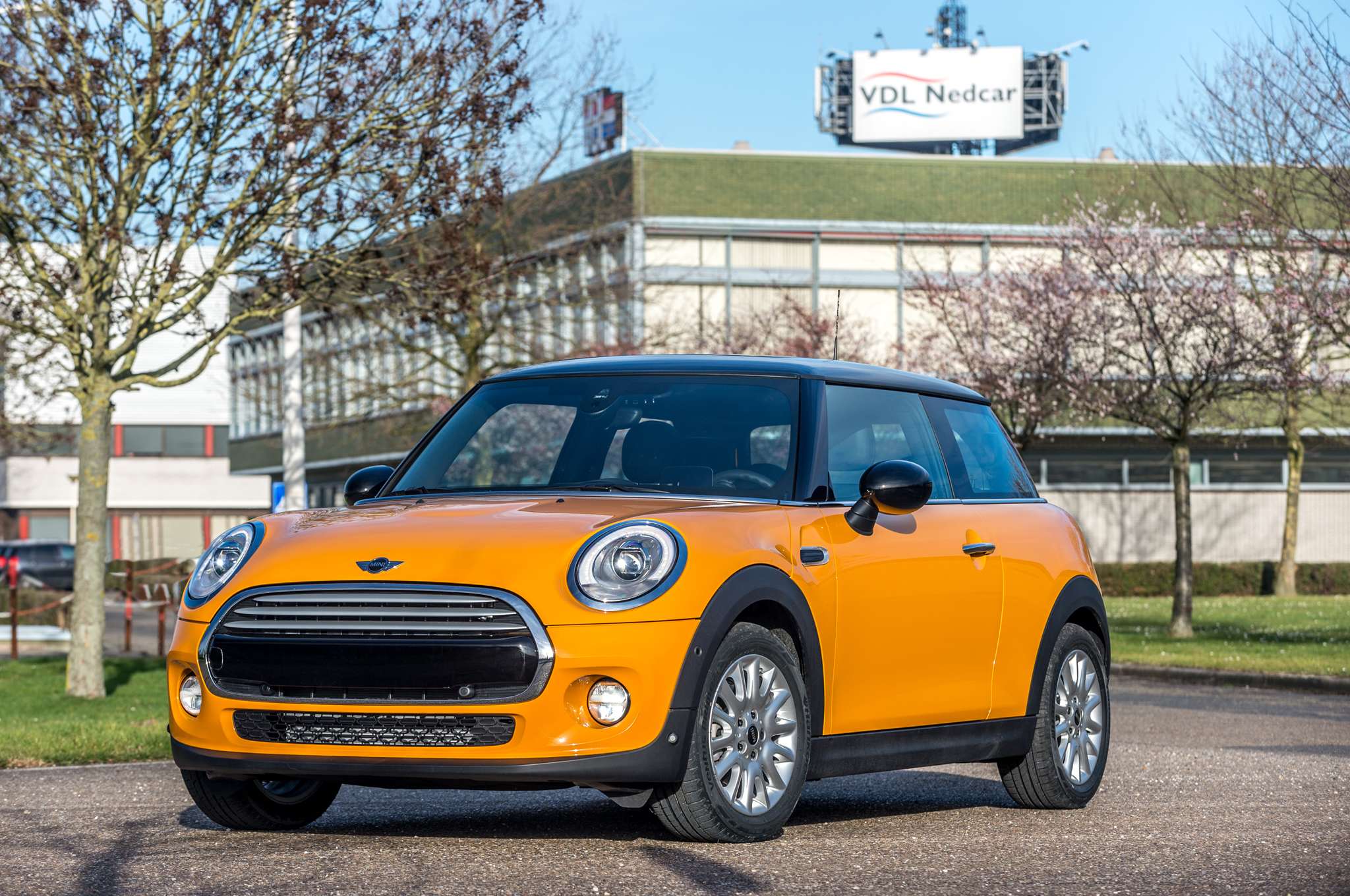

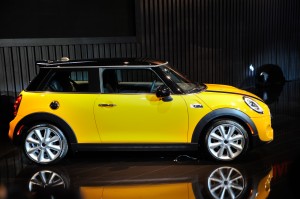

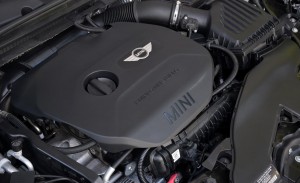
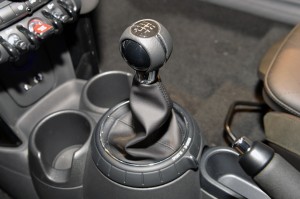
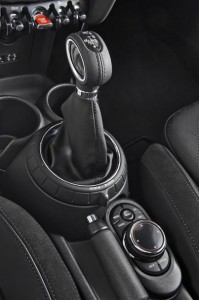










I honestly didn’t mind when BMW made the MIni larger… the first time.
But the second time?
I dunno. If I wanted a larger car, I’d get something else.
When I want a Mini, I want a Mini. I don’t want a Maxi.
I like the integrated tachometer/speedometer.
This Mini seems to be a very attractive package…with a fatal flaw.
I’m willing to pay for premium gas, and risk higher maintenance expenses down the road for a cute, fun, efficient car like this.
But if that POS is suffering crippling electronic glitches from the very beginning…..I won’t have anything to do with it!
Hi Mike,
Yeah. It concerned me, too. Or rather – would, if this had been my car.
Now, to be fair to Mini (and BMW), this car may have been abused (by journalists) or it could be a pre-production glitch.
But it’s also the first time in years I’ve had a functional problem with a press car.
Some fleeting thoughts…
So…it’s over 5 inches longer . I remember the first year RAV4, saw a two-door model the other day. Boy! It was small. Now the Rav is the size of a Sequoia. Seems to be the trend, start small, hook an audience and grow. Now the Mini looks like an X-Box on ‘roids. If it grows a little bigger and slopes the rear bonnet, I think Chrysler may have found their smaller Coffin-Car.
The three cylinders begin to land. I warned my college class about this, thanks in large part to Eric and his ability to keep us informed. With the advent of higher compression ratios (over 14.1:0 in the case of HCCI) we now have engines that would make a race tech blush 20 years ago. And with the closer tolerances comes the need for better fuel, oil and service. Not only that but repair costs will go through the roof. Anybody remember the VW diesel with the selection of three possible head gaskets when it was repair time? We are on the verge of disposable cars or at least engines. Last time I heard that phrase was when I owned a Mach III 500. They were disposable because the replacement bike was cheaper than new. The current and future cars will be disposable because the factory won’t allow anyone to repair their version of a Swiss watch.
A lot has been made of the fact that young people aren’t buying new vehicles because of 1) too expensive and B) they all live in their cell-phones and have no life outside of the 6 sq. in. portal. Pricing a vehicle from $21K-$31 is not going to help. Now that obama has turned the illegals loose on the job market, wages will continue to be depressed and wages will not support this level of c ost. Welcome to the world of unintended consequences.
What this world needs is a good 5 cent cigar…or a good $10K car…but not from Indonesia.
Ditto all that, Dale (and thanks for the kind words!)
I hesitated to mention possible/potential down-the-road repair/replacement costs because I sometimes think I harp on that too much. But all things considered, I think it’s a valid concern.
DI (and turbo’d) engines have advantages, but the disadvantages – both real and potential – ought not to be dismissed.
PFI engines are already (for the most part) not-DIY serviceable and thus have the potential to render a car economically unfixable. DI is going to push that to the next level, meaning more throw-away (and sooner). Ditto the turbos.
I’d punch out of this crazy ride if I could….
eric, as I’ve pointed out before, practically anything you can think of equipment wise, has been diesel turbo’d for decades. Till recently, they haven’t had the EPA breathing really hard down their collective necks, although that’s affecting everything from trackhoes to semi’s now. For decades though they fairly much had a continual learning curve of what worked, how much was too much, what bearing to make large, what oil supply to increase, etc. etc. Up until the EPA really got down on road machines, they were extremely reliable, now, not so much. All those pieces of equipment that didn’t have to meet some EPA rule though continued to become more and more sophisticated with tubo’s hasting so long they’d finally succumb to tens of thousands of heat cycles and literally blow up. Nobody complained cause they’d gone longer than believable anyway so a machine with 20,000 hrs on it that the turbo quit was a great thing. Who could complain? Now outstanding and superior engineering and construction techniques combined with advances in metallurgy are about to take their worst hit, trying to meet unreasonable expectations with ridiculously complicated “emissions bs”.
I think we’ve seen our most reliable vehicles and it’s all downhill now. Think early 90’s Big 3 diesel pickups. No computer, not a hell of a lot to break so they continue to survive, at least the ones with good transmissions.
I agree 8, tier 4 interim and final are the death knell for dependability of machinery.
We have a 93 hitachi ex 270 excavator. 20,000 hrs on the Hino diesel in it. You can’t kill that sucker. When the wiring harness got too greasy to work, we just bi passed it and installed a manual kill switch and alternator switch. It still runs like a champ. You could never do that with a machine post 96 or so. Too damn much electronics. Now add tier 4 emissions to the computers. Fucking nightmare to put it nicely.
ancap51, now get on a new piece of fairly much anything. I like the fact that the seat and all the controls float, not nearly as abusive. I climb into a big loader recently that looked like a computer game. Probably 50 buttons I could have pushed. So I push the button(touch control)that has a bright red P on it and the systems comes to life, ok, not really, it just allows me to proceed. I just turned off the parking brake. Then there’s the “on” or something other button so I press it, nada. Oh crap, gotta press the “code” button(not intuitive at all….who knows what that little symbol is?” and the screen comes to life so I holler down and get the code, punch that in and it waits and then shows me it’s decided I can “operate”. Now we’re cookin so I push on the green Start button and nothing happens since I’m just entering code into the computer. A few seconds later the starter engages and it fires up. I grab the main control for nearly everything, push the 3 position rocker switch down for forward, step on the fuel pedal and drop that bucket and away we go. The speed of the controls are so fast it’s like trying to caress a sunburnt nipple….easy does it there, real soft. How long do you think all that’s going to be worry free(i’ve seen em not work brand new)? What is the matter with very easy controls that go straight to a hydraulic valve? And for the most part they don’t do that, they’re just “electric” and not computerized. it’s the single stick, many button controlled dozer that screws me up. So now we have virtually bullet-proof mechanicals that might or might not run for a plethora of mechanically unrelated problems. My old DitchWitch had a plunger handle that moved a tension pulley. What’s to go wrong? A pulley bearing? Oh, that’s so complicated, help. Maybe nobody has the strength to push and pull that thing though. They’ve sat on the couch their entire lives wearing themselves out with game controllers, almost identical to what controls big equipment now. Hhhmmmm, wonder who their new engineers are?